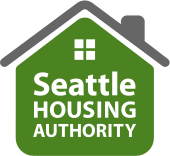SEATTLE—January 6, 2007—Asthma is the sixth-ranking chronic condition in Washington State and the leading serious chronic illness of children all across the country.
Thanks to partnerships among Seattle Housing Authority, Neighborhood House, Public Health - Seattle & King County, and University of Washington’s Department of Environmental and Occupational Health Sciences low-income families at High Pointhave options to combat asthma and other respiratory problems.
With $1.8 million in Healthy Homes grants from the U.S. Department of Housing and Urban Development and the National Institute of Environmental Health Sciences these partners are implementing a long-range program to build 35 Breathe Easy homes. These are homes designed to improved indoor air quality, and ultimately reduce asthma attacks in children.
High Point's Breathe Easy homes are the first of their kind in the nation and have special features to improve overall indoor air quality and reduce indoor air pollutants.
Residents will take part in a study to link the new construction methods to the incidence and severity of asthma attacks. As part of this project, an environmental outreach program will focus on improving resident health in general.
Tesfai Gebrezgi was born in Ethiopia and has lived in public housing for 11 years. He has worried about his son’s asthma for years. His son, now 12 years old, had severe asthma attacks for years. Emergency trips to the hospital became "normal" for the family.
When Gebrezgi heard about the Breathe Easy homes at High Point, he was living at Yesler Terrace, Seattle Housing’s 65 year old garden community. He immediately started filling out the necessary paper work to move. Six months ago Gebrezgi and his son moved to their new Breathe Easy home at High Point. He says with relief that his son has not had any attacks or emergency visits to the hospital since they moved in.
Residents were chosen by a process that assessed the severity of the children’s asthma. Participants volunteer to follow a lifestyle to ensure the highest possible air quality for the children, including no smoking, no pets, and restricting certain cleaning agents.
Also, as part of the Breathe Easy Homes research project, coordinators work with the families to reduce asthma triggers in their homes. For example, health coordinators teach housekeeping techniques to reduce dust and other allergens and distribute bedding covers, green cleaning products and other supplies to promote good health.
"I don’t have to worry that my son could stop breathing at any minute from an asthma attack anymore – thanks to being able to live in a Breathe Easy home at High Point," said Gebrezgi. "Since we moved into our new home my son is doing much better. His medication dosage has been lowered, he can breathe better and he hasn’t had any attacks."
The Breathe Easy homes include airtight construction, insulated windows and an insulated foundation to minimize dust, pollen and other contaminants that can enter from outside. As part of the improved indoor air quality package, an air-tight drywall approach was used to reduce air leakage through exterior walls, minimizing opportunities for mold growth.
Positive ventilation is included to remove stale air and filter incoming fresh air Hydronic heating, instead of forced-air heating, is included to reduce airborne particles and organisms. Hard flooring, such as linoleum, replaces traditional carpet that can trap dust and allergens.
Window blinds are used in the units instead of curtains to reduce trapped dust. A HEPA filter vacuum is in each unit to efficiently remove dust and other toxins and debris. Even the landscaping surrounding the homes was designed to reduce seasonal pollens.
